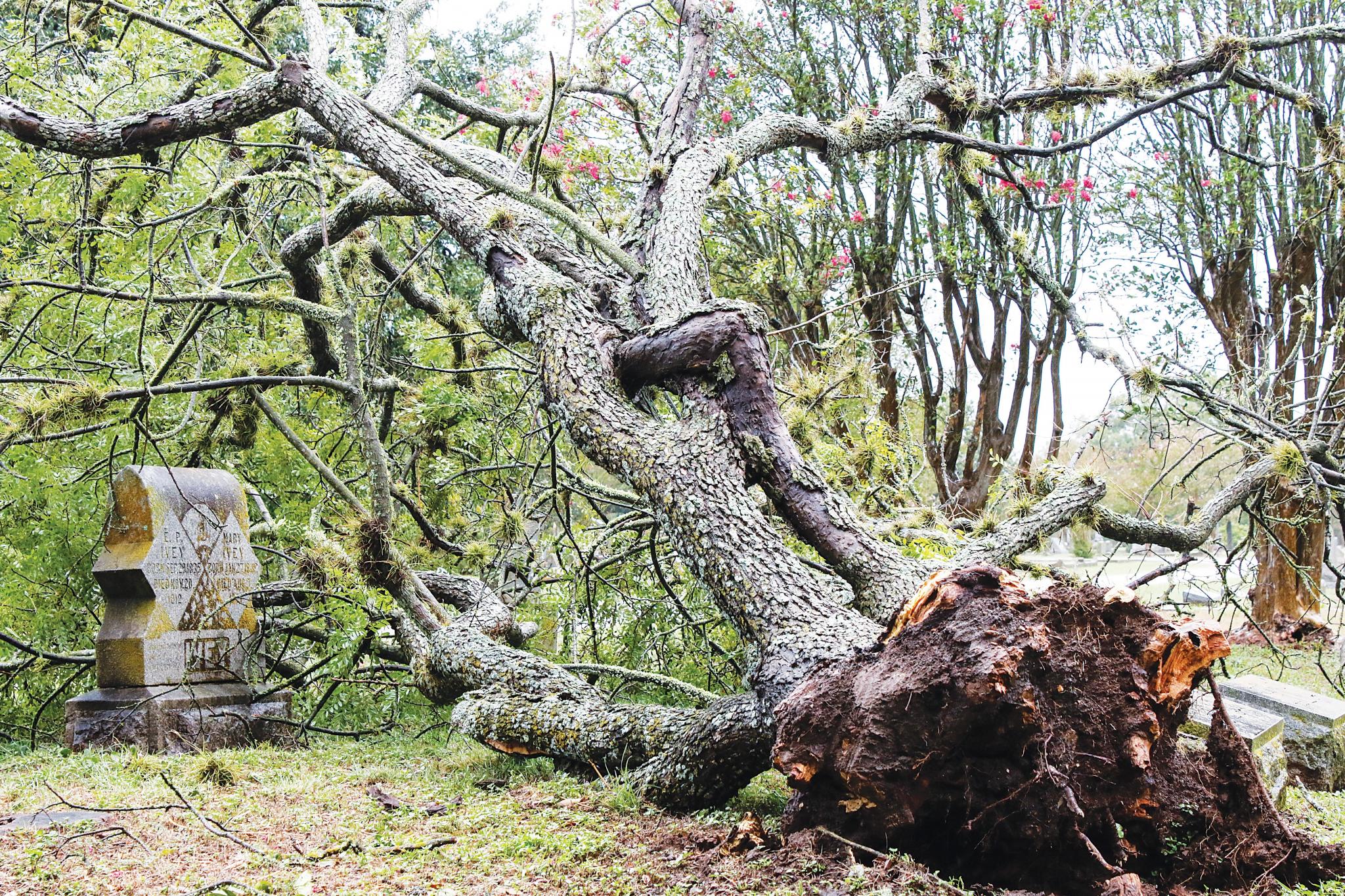
Harvey downed many trees at the San Marcos City Cemetery. Daily Record file photo
Taking a look back at Hurricane Harvey
This weekend marks a year since Hurricane Harvey made landfall in Texas, dropping unprecedented amounts of rain over the Houston area, devastating towns on the Texas coast and bringing winds and some flooding to Central Texas. The U.S. Geological Survey reported that the storm’s eight-day rainfall totaled more than 60 inches in some locations — more than average annual rainfall for East Texas and the Texas Coast. The area affected was also larger than in previous rainfall events, USGS said.
Gov. Greg Abbott declared 54 counties disaster areas, including Comal, Caldwell and Guadalupe, but not Hays. The county was spared the brunt of the storm, but the National Weather Service reported a 53 mph wind gust at the San Marcos Airport, and 9.08 inches of rain was recorded at a gauge near San Marcos.
Lessons learned
Even though Harvey did not cause much damage in Hays County, the storm did leave an impression — one that has led the San Marcos Electric Utility (SMEU) to make some changes.
During the storm, city officials said, SMEU received more than 1,000 calls, with more than 400 outages occurring in one day. Many of the calls were repeat calls from customers without power for a long time, and many customers had multiple outages because as soon as a crew repaired a line that had been hit by a tree or limb, another tree or limb would fall and cause another outage in the same area. City officials said that at any given time during the weekend when Harvey hit, about 500 customers were without power.
Tyler Hjorth, assistant director of public services-electric utility, said that SMEU workers have plenty of stories of continual outages from Harvey.
“We had outages and would move on to other outages, and then a tree would fall two blocks away from where we just were,” he said.
Because trees and tree limbs were often the culprits in outages during the storm, Hjorth said, the city has devoted more funds to tree trimming crews and contractors.
“As a direct result of the hurricane, one of the first changes made is the amount of tree-trimming crews we have,” he said.
Moreover, the city arborist has helped SMEU crews identify fast-growing trees and trees around the city that would be vulnerable to limb breaks or getting uprooted in a storm.
Hjorth said the hurricane also helped to expose old equipment and old power lines around the city.
“We are linking and adding some resilience to the system,” he said, to try to minimize the extent of outages.
Another development that Hjorth said was a direct result of customer feedback during and after Harvey is an improved phone system.
“Our customers were vocal about the length of time required to report outages and the slow call-back times from the city,” he said. “We have since implemented an improved phone system with an automated options for customers to report outages and get information. The decreased call volume allows staff to either respond or call back much faster to those customers who want to talk directly to staff during an event.”
Hurricane Harvey was the first Category 4 hurricane to hit the Texas Coast since Carla in 1961.
Graphic by Colton Ashabranner
Hard Times on the Coast
A year after Harvey’s landfall, the Kaiser Family Foundation and Episcopal Health Foundation surveyed residents of 24 counties on the coast and in the Houston area about their recovery. Many say that their lives are still disrupted. The survey finds 8 percent of all residents remain displaced from their pre-Harvey homes. This includes 20 percent of Beaumont/Orange/Port Arthur area residents.
“This survey shows how much Harvey continues to haunt many across coastal Texas, with significant shares reporting ongoing challenges with their housing, finances and health,” said Drew Altman, president and CEO of the Kaiser Family Foundation. “Residents’ top priorities include both preparing for future storms and providing financial assistance and help rebuilding homes for those who need it.”
“One year later, many of those with the fewest resources are still struggling to bounce back from Harvey’s punch,” said Elena Marks, president and CEO of the Episcopal Health Foundation. “This kind of information is crucial to letting government and other recovery groups know what Texans still need for a longterm comeback.”
rblackburn@sanmarcosrecord.com
Twitter: @arobingoestweet












